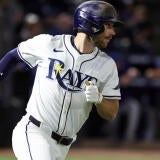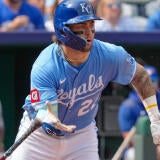2019 Fantasy Baseball Draft Prep: Breakouts 1.0 feature this year's stars, David Dahl, Luis Castillo
Guys like Joey Gallo and Jack Flaherty have already established themselves as worthwhile assets in Fantasy, but Scott White thinks they're about to step up their production. He shares his 12 favorite breakout candidates.
Want to get a jump on the competition? Go to the CBS Sports app on your phone, open up "Settings" and sign up for Fantasy alerts to get the latest from our Fantasy baseball team as soon as it's available.
If you're looking for sleepers, you've come to the right place.
I know: These are technically breakouts. But isn't a breakout just a special kind of sleeper? They're under the same umbrella, at least. It's all about getting bang for the buck.
These particular "sleepers" are already valued on some level, but they're about to step up their production in a way we haven't seen yet. They're breaking out, and you'll be freaking out if you're the one who invests in them.
German Marquez's 2018 numbers certainly aren't lost on anyone and maybe were enough of a breakout for some, but what they sell short is just how good he was once he got good. It was a tale-of-two-seasons scenario in which the 23-year-old delivered a 5.53 ERA, 1.55 WHIP and 9.1 strikeouts per nine innings over his first 16 starts compared to a 2.47 ERA, 0.95 WHIP and 11.6 strikeouts per nine innings over his final 17, making it safe to assume an actual skill change occurred that renders those early numbers obsolete.
The pitch data supports the narrative that some mechanical tweaks unlocked his true potential. He learned to avoid slowing down his delivery on his offspeed pitches and in doing so transformed his slider and curveball into elite swing-and-miss offerings. There will be some reluctance to draft Marquez both because owners instinctively distrust developments they didn't see coming and because he pitches at Coors Field, which has a unique ability to expose warts and amplify mistakes. But considering the upside, investing in Marquez after the top 20 are off the board seems like a worthwhile risk.
After losing all of 2017 to a strained rib cage, David Dahl missed the middle two months last season with a fractured foot. Even when healthy, the Rockies hesitated to make him a regular part of their lineup. The wait didn't deliver the expected payoff, in other words, mitigating the hype right at the point when he's poised to step into an everyday role.
Many of the extraneous outfielders the Rockies employed last year, most notably Carlos Gonzalez, are gone, and Dahl did enough in a part-time role to earn a larger portion of the pie now. You could even argue his .311 BABIP was low by Coors Field standards, given that its expansive outfield allows for more batted balls to drop — Rockies' hitters have a .339 BABIP over the last decade at Coors. Credit Dahl with another 15-20 points of batting average, and he starts to look a lot like Charlie Blackmon — a welcome comparison for a player you're likely to draft as your third outfielder.
Few players in major-league history have managed to hold down a job with the 35 percent strikeout rate that has become the norm for Joey Gallo, so nobody bats an eye when he bats .200. But there are actually two factors contributing to the awful batting average: the strikeouts, yes, but also an extreme fly-ball tendency that, while theoretically boosting his power, also means he's too often hitting into easy outs — something that someone who so rarely makes contact simply can't afford to do.
And the reality is that he probably doesn't have to sell out for power, given how hard he hits the ball. Gallo himself seemed to realize it in the second half, trading off some of those fly balls for an elite line-drive rate. His BABIP then rose from .228 to a more reasonable .286 and his batting average from .187 to .239. A .240 batting average may not sound so great on its own, but for Gallo it's like the difference between being a .265 hitter and a .300 hitter. It gives him a fighting chance of muscling his way into the top five at first base with numbers more like those of a third-rounder than a sixth- or seventh-rounder.
The trouble with projecting a starting pitcher breakout in today's landscape is that pitchers no longer adhere to the conventional formula of gradually adding innings to what's a fairly obvious talent base. More and more organizations are deciding there's no need to push them beyond where they already are, thereby inflating the value of the few established innings eaters while turning the rest of the position into a mangled, unpredictable mess.
But Jack Flaherty's numbers the third time through a batting order last year were about as good as the first and second time through, which suggests he's capable of sustaining the same effort level deep into games with a complete enough arsenal to keep hitters guessing. The times he went only five innings were usually a product of inefficiency — i.e., not throwing enough strikes — which is something you can reasonably expect to improve with experience.
Flaherty fits the traditional breakout model of having the capacity to take on a bigger workload while flashing big-time talent, namely two elite breaking balls that contributed to him having the ninth-best swinging strike rate among all qualifiers last year.
It's not altogether wrong to say Jurickson Profar already broke out last year after a myriad of injuries and missed opportunities came dangerously close to wrecking the one-time top prospect in baseball. But a closer look reveals he was actually unlucky, his .269 BABIP ranking 116th among the 140 qualifiers.
Sometimes a low BABIP is justified, like in Gallo's case thanks to all the fly balls, but Profar ranks in the middle of the pack in both fly-ball rate (bad for BABIP) and line-drive rate (good for BABIP). He should, then, rank in the middle of the pack in BABIP, profiling as more like a .285 hitter who controls the strike zone with emerging power. In line to be the Athletics' second baseman, he's on the verge of quadruple eligibility and perhaps another jump in production, his bat beginning to resemble Anthony Rendon's.
The threshold for a Luis Castillo breakout is only lower after he fell short of those hopes a year ago, but many of the traits that prompted the initial enthusiasm remain intact. He still had a fastball pushing triple digits regularly and still has a changeup ranking among the best swing-and-miss pitches in baseball. His issues were more related to consistency, both in terms of mechanics and pitch location, which explains the extreme highs and lows he experienced throughout the season; his ERA went from 7.85 in April to 3.48 in May to 6.75 in June to 2.25 in July to 5.57 in August, before finishing strong with a 1.09 mark in September.
Castillo ended the season on his highest note, and because he tends more toward ground balls and hasn't shown any major control issues, he's too optimized for today's three-true-outcomes environment to remain just a middling performer.
Coming off a type of shoulder surgery that was completely untested within the hitter ranks but has historically left pitchers fighting for their careers, it's understandable that Michael Conforto didn't look like himself out of the gate. But his .273 batting average and .895 OPS in the second half were basically in line with the .279 batting average and .939 OPS he delivered in 2017, right down to the BABIP and home run-to-fly ball rate, so there's ample reason to believe it's his truer form. And that form was good for 3.40 H2H points per game, which would have landed him right between Juan Soto and Aaron Judge, at least as far as outfielders go.
Nick Pivetta's FIP was nearly a run lower than his ERA in 2018, which right off the bat suggests he had some bad luck, suffering at the hands of a league-worst defense and inflated BABIP. In the areas over which he has the most control, though, he took a big step forward, his 10.3 strikeouts per nine innings ranking 11th among qualifiers, with his 3.69 strikeout-to-walk ratio ranking 21st. And the FIP itself wasn't totally pure, having been inflated by one of the worst home run-to-fly ball rates in the game. Bad luck all around, right? Between the Phillies' efforts this offseason to shore up their defense and good, old-fashioned statistical regression, Pivetta isn't such a long shot for Carlos Carrasco-type numbers in his third major-league season.
Though his talents were plainly evident, the Pirates never seemed content to let Tyler Glasnow do his thing, encouraging him to induce contact early in the count with a two-seam fastball rather than tackling his efficiency issues head-on. The Rays took the opposite approach upon acquiring Glasnow at last year's trade deadline, and the results were immediate. His strike percentage jumped from 59.4 with Pittsburgh, where he was pitching out of the bullpen to 63.4 with the Rays, resulting in a not-so-terrible 3.1 walks per nine innings. And, as expected, his high-90s fastball and high-spin curveball missed bats by the bundle.
The only issue was an elevated home run rate that his heavy reliance on a curveball should help combat. Even if it doesn't and he's destined for a 4.00 ERA, he'll have an impact as a guy who delivers 6-10 strikeouts every start. Meanwhile, H2H points owners will get to enjoy his relief pitcher eligibility for another year.
For most of his career with the Dodgers, Marlins and Yankees, Nathan Eovaldi was the poster boy for toothless velocity, consistently ranking among the hardest throwing pitchers yet failing to miss bats regularly. Things changed, though, once those darling Rays got their hands on him, convincing him to curtail the use of his slider in favor of a cutter, which doesn't break as much and looks more like his fastball coming out of his hand. And that was precisely the point: His fastball lacked deception, so they tweaked his arsenal to give it some and it immediately became one of the majors' best at coaxing swings and misses, doing so about 12 percent of the time compared to only 7 percent previously.
It didn't transform him into some elite bat-misser, no, but the 8.2-per-nine-inning strikeout rate was a career-best, as were more or less all his numbers. It earned him a big payday from the Red Sox, who could make him a winner on the level of a Rick Porcello if he can just keep a steady hand.
Normally a season-ending shoulder surgery isn't an encouraging development for a player, but Jesse Winker put a positive spin on his by revealing he had been playing through a torn labrum for a couple years. That timeline corresponds with his sudden loss of power in the minors, where he hit 36 home runs in his first 927 at-bats but only 20 in his final 1,135.
What's more interesting is he was finding his power stroke in the majors regardless — something that tends to happen for prospects with a plus hit tool when they reach the majors and are actually given pitches to hit. All seven of his home runs came in his final 45 games, during which he batted .348 with a 1.005 OPS and more walks (29) than strikeouts (22).
Did I mention the plus hit tool? Seeing more strikes? Yes, WInker has always been a remarkably patient hitter, but the Joey Votto comparisons only begin there. In everything from his line-drive rate to his fly-ball rate to his hard-hit rate to how often he pulls the ball or hits it the other way, he profiles exactly like the franchise icon, whose batted-ball tendencies have routinely him BABIPs in the .350 range. It's like the Reds took their best player and cloned him, which puts pesky matters like shoulder surgeries in proper perspective.
Technically, Tyler Skaggs is more like a bounce-back candidate than a breakout candidate given that his breakout was plainly evident for the first two-thirds of last year. But the crash came so suddenly and so spectacularly that it's safe to assume those who didn't own him don't even remember he had a 2.62 ERA on July 30.
He made the mistake of pitching through a groin injury that day, giving up 10 earned runs in 3 1/3 innings, and then compounded the mistake by returning too soon from the DL and giving up seven earned runs in 3 1/3 innings. He'd make three more appearances after another DL stint, but he was never right after the initial injuries, which is why his numbers wound up where they did.
The guy who put together a 2.62 ERA through 19 starts, though, did so with a .313 BABIP and 2.94 FIP. He offered little reason to doubt what he was doing, so unless you doubt what fouled it all up, you can trust you're getting a significant contributor here.






































